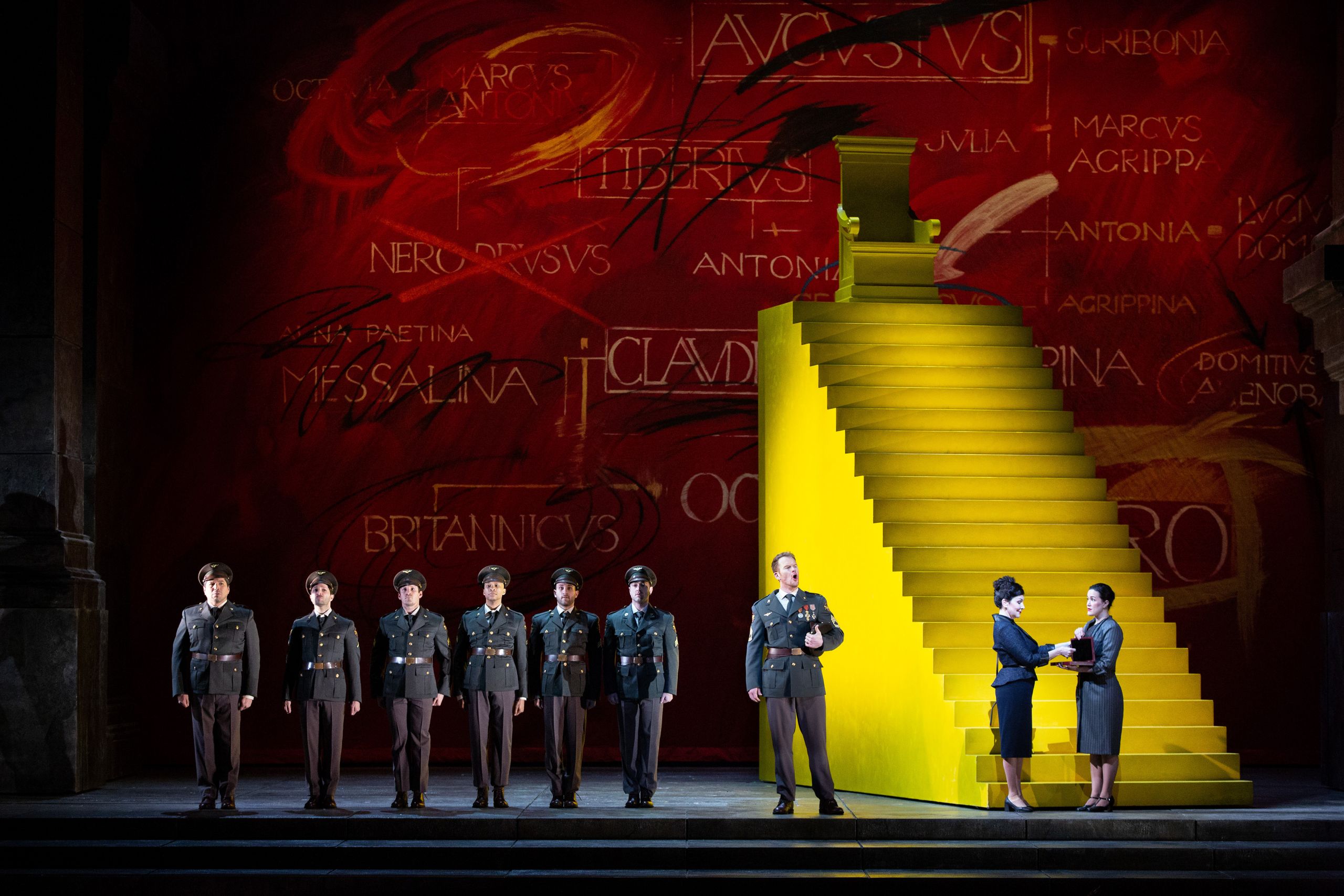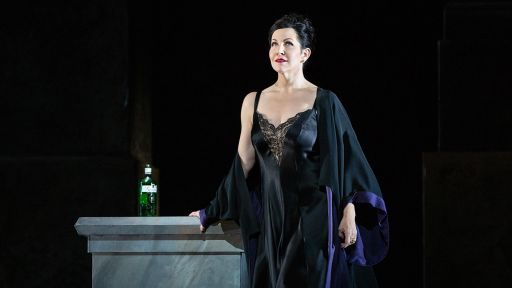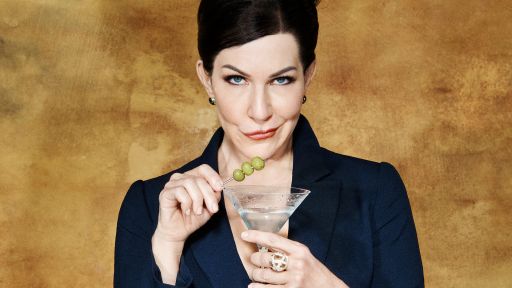By Katelin Levy
Julia Agrippina or Agrippina the Younger was born November 6th in the year 15 C.E. Among classists, she was considered the most powerful and ruthless women of the Julio-Claudian dynasty, and yet many are more likely to recall the rule of her son, Nero. In George Frideric Handel’s opera, Great Performances at the Met: Agrippina airing Sunday, June 7 at 12 p.m. on PBS (check local listings), he gives her machanations a spotlight in a three-act black comedy.
While the main cast of characters in the opera is almost identical to that of their historical counterparts, there are some distinct differences in Handel’s interpretation.

A scene from Handel’s “Agrippina.”
Photo: Marty Sohl / Met Opera
The Opera
Handel’s Agrippina premiered in Venice on December 26, 1709 and was immediately successful. This opening night kicked off a series of 27 consecutive performances. As was the style, Handel and his librettist, Vincenzo Grimani, borrowed heavily from Claudio Monteverdi’s 1642 opera, L’incoronazione di Poppea (The Coronation of Poppaea). They also used Suetonius’ Life of Claudius and Tacitus’ Annals as source material. All main characters, except for Claudius’s servant Lesbo, are historical.
By the mid-18th century, Handel’s work was no longer part of the Zeitgeist, and Agrippina was not performed again until the 20th century. As Handel’s works resurge through contemporary opera productions, Agrippina has taken off, inviting modern interpretations like this 2020 Metropolitan Opera staging. With several large painted backdrops and one golden staircase leading to the coveted throne, Sir David McVicar’s production provides a simple yet effective staging for all the plotting, backstabbing, sexual tension and revenge in Agrippina.

Joyce DiDonato as Agrippina and Matthew Rose as Claudio in Handel’s “Agrippina.”
Photo: Marty Sohl / Met Opera
The History
The Julio-Claudian dynasty was the first Roman imperial dynasty lasting nearly 100 years from 27 B.C.E. to 68 C.E. During this time period, five emperors held power: Augustus, Tiberius, Caligula, Claudius, and finally Nero. For those who are unfamiliar, the Julio-Claudian dynasty was a Game of Thrones-esque grab for power with relatives murdering each other to either ensure that they themselves or their children were in line to become the next emperor. A family tree, as shown in the first image above, has been integrated into the set. Names are haphazardly scribbled out representing deaths or circled to show who still remains in the way of Agrippina’s plans.
Agrippina the Younger was no different than the rest of her ambitious family, other than that she dared to be an influential woman (albeit evil). She was the great-granddaughter of Augustus, the sister of Caligula, the wife of Claudius, the mother of Nero, and the de facto Empress of the Roman Empire from 54-57 C.E. When her brother—the infamous Caligula—came to power, Agrippina began to gain more status from the honors he bestowed upon her. For the first few years, Agrippina remained in Caligula’s good graces, until their sister, Drusilla, died, most likely from a virus. By then Caligula’s descent into madness had begun, and he no longer cared for his other sisters. In 39 C.E. Agrippina, along with her sister Livilla, and Drusilla’s widower, plotted to murder Caligula. The scheme known as the “Plot of the Three Daggers” failed. Agrippina and Livilla were exiled and Drusilla’s widower, who was supposed to usurp the throne, was put to death.
Upon Caligula’s murder in 41 C.E., Agrippina’s uncle and future husband, Claudius, recalled her from exile. Agrippina would have to wait another eight years before she could first claim the title of Empress, although it lacked real power. Over the next several years Agrippina would work tirelessly to eliminate anyone who didn’t envision Nero on the throne. She framed people, poisoned them, or had them exiled. And so this is where her story begins in Handel’s Agrippina. Spoilers ahead.

A scene from Handel’s “Agrippina” with Joyce DiDonato in the title role.
Photo: Marty Sohl / Met Opera
The Opera vs The History
In each section below there is first a description of the character as described in Handel’s opera and then a description of the same character as a historical figure.
Claudio/Claudius
Agrippina presumes Claudio is dead after his ship was caught in a violent storm, whereupon she begins her scheming and prepares to announce Nerone as the next Emperor of Rome. Unfortunately, Claudio is not dead and was saved by Ottone who he has announced as his heir.
Historically, it is believed that Agrippina poisoned Claudius, although there are variations in accounts as to the exact method she used. It is also possible that he died of natural causes at 63 years old. Her potential motive for murder was that Claudius began to regret adopting Nero as his heir, and returned to favoring his son, Britannicus.
Ottone/Otho
In the opera, Ottone is a dewy-eyed Roman officer whose claim to the throne is only due to Claudio’s gratitude. He is head over heels in love with Poppea, and will only accept the claim to the throne if she can be Empress.
Otho and Nero were close friends and Poppaea made the move to take Otho as her second husband in hopes that she could get closer to Nero. Shortly after her marriage to Otho, Poppaea became Nero’s mistress and would remain so until their eventual marriage.
A Not-so-Fun Fact: Ironically, Otho would later become the Emperor of Rome after Nero’s death. He reigned for three months during the “Year of the Four Emperors,” a period of civil war for the Roman Empire in 69 C.E.
Poppea/Poppaea
Poppea presents herself as another main character on par with Agrippina. She juggles the affections of Ottone, Nerone, and Claudio and deciphers Agrippina’s schemes. In the end, she declares her love for Ottone who concedes the throne to Nerone so that they can be together.
Poppaea and Nero were not married until after the execution of Agrippina in 59 C.E. In fact, Nero was still married to his first wife Claudia Octavia until 62 C.E. when Poppaea became pregnant with his child. Poppaea then pressured him to divorce Octavia and shortly after execute her. Some sources believe Poppaea was the one to suggest Nero execute Agrippina.
Nerone/Nero
Nerone is a conniving man-child who is willing to do his mother’s bidding in order to ascend to the throne. He is in lust with Poppea, and ideally would like her as his Empress, which Agrippina opposes. After Poppea’s proclamation of love for Ottone, Nero is left only with the throne, an outcome which he is not disappointed with.
Nero ascended the throne at age sixteen, the youngest emperor to date. It was during the first three years of his rule when Agrippina exerted her influence and began murdering her political rivals. Ultimately, it is unclear why they had a falling out. Some point to Poppaea as the source of the conflict, because of Agrippina’s love for Octavia. Suetonius noted that Nero regretted executing Agrippina and Octavia, and years later still had recurring nightmares about the pair.
Agrippina/Agrippina the Younger
Agrippina works hard to make sure that Ottone does not become heir over her beloved son. After persuading Claudio to name Nerone as his successor she is betrayed by her lovers, Pallante and Narciso. Claudio confronts her, and using his own infidelity against him she skillfully removes all blame from herself and achieves her goal of Nerone becoming the next Emperor of Rome.
Much like her operatic counterpart, Agrippina the Younger was a ruthless, powerful, intelligent woman who was unafraid to use her political influence whenever possible. Although she is not a figure to look up to she should be given more credit for exerting a long-lasting influence in the early days of the Roman Empire.
To see Joyce DiDonato’s stunning performance as Agrippina, watch as she pleads with the gods to put Nerone on the throne.




